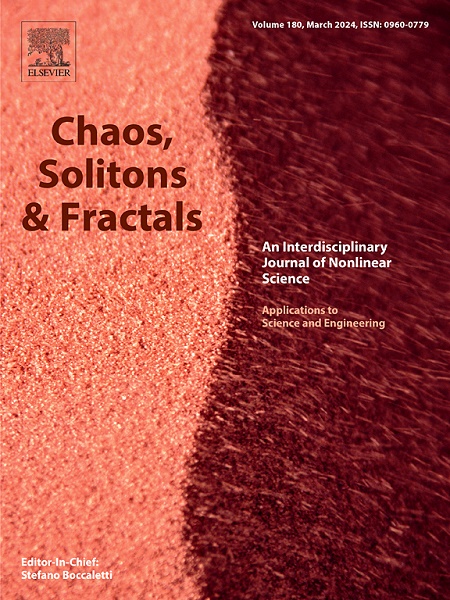Modulational instability and dynamics of multidimensional dust ion-acoustic wave envelope in collisional dense astrophysical dusty plasma
IF 5.3
1区 数学
Q1 MATHEMATICS, INTERDISCIPLINARY APPLICATIONS
引用次数: 0
Abstract
We study the nonlinear propagation of (2+1)-dimensional modulated dust ion-acoustic waves (DIAW’s) envelope considering a semiclassical, two-fluid hydrodynamic model incorporating the effects of electron exchange–correlation potential, quantum Bohm potential term and degenerate pressure in unmagnetized collisional dusty plasma. We employ standard multiple-scale perturbation technique to obtain a (2+1)-dimensional modified nonlinear Schrödinger (mNLS) equation describing the slow modulation of DIAW packets’ evolution. It is noticed that the NLS equation is modified with a damping term due to the presence of dust-neutral collisional effects, which significantly alter the behavior of the system. Also, we investigate the oblique modulational instability (MI) by means of the corresponding mNLS equation. Various instability criteria and instability domains are identified exclusively, and the corresponding growth rate of MI is obtained in the unstable domain. Moreover, analytic solutions (such as breather solutions) of the mNLS equation are obtained using Hirota’s method. In the current framework, MI enhances coherence within nonlinear plasma systems by reducing wave randomness and mitigating random phase fluctuations. This process enables the formation of coherent, self-organized structures such as DIA envelope solitons or wave collapse. These variations may result in rogue waves, which are unexpected localized wave formations within the turbulent plasma environment. We also perform parametric analysis and observe that the key plasma parameters, viz., electron exchange–correlation potential, ion and electron number densities, remarkably change the criteria and domains of MI, as well as the characteristics features of DIAW’s propagation (via the rough and breather structures). The relevance of this present theoretical investigation is pointed out in dense astrophysical objects like the interior of white dwarf stars for exploring the nonlinear dynamics of DIAW.
碰撞致密天体物理尘埃等离子体中多维尘埃离子-声波包络的调制不稳定性和动力学
本文研究了(2+1)维调制尘埃离子声波(DIAW)包络的非线性传播,考虑了电子交换相关势、量子玻姆势项和简并压力在非磁化碰撞尘埃等离子体中的半经典双流体力学模型。我们采用标准的多尺度摄动技术得到了一个(2+1)维修正非线性Schrödinger (mNLS)方程,描述了DIAW包的缓慢调制演化。值得注意的是,由于尘埃中性碰撞效应的存在,NLS方程被修改为阻尼项,这显着改变了系统的行为。同时,我们利用相应的mNLS方程研究了斜调制不稳定性(MI)。对各种不稳定判据和不稳定域进行了独家识别,并在不稳定域中得到了相应的MI增长率。利用Hirota的方法得到了mNLS方程的解析解(如呼吸解)。在目前的框架下,MI通过减少波的随机性和减轻随机相位波动来增强非线性等离子体系统内的相干性。这个过程能够形成连贯的、自组织的结构,如DIA包络孤子或波塌缩。这些变化可能导致异常波,这是湍流等离子体环境中意想不到的局部波形成。我们还进行了参数分析,并观察到关键的等离子体参数,即电子交换相关势,离子和电子数密度,显著改变了MI的标准和域,以及DIAW传播的特征特征(通过粗糙结构和呼吸结构)。指出本文的理论研究对于探索DIAW的非线性动力学在白矮星内部等致密天体物理中具有重要意义。
本文章由计算机程序翻译,如有差异,请以英文原文为准。
求助全文
约1分钟内获得全文
求助全文
来源期刊

Chaos Solitons & Fractals
物理-数学跨学科应用
CiteScore
13.20
自引率
10.30%
发文量
1087
审稿时长
9 months
期刊介绍:
Chaos, Solitons & Fractals strives to establish itself as a premier journal in the interdisciplinary realm of Nonlinear Science, Non-equilibrium, and Complex Phenomena. It welcomes submissions covering a broad spectrum of topics within this field, including dynamics, non-equilibrium processes in physics, chemistry, and geophysics, complex matter and networks, mathematical models, computational biology, applications to quantum and mesoscopic phenomena, fluctuations and random processes, self-organization, and social phenomena.
 求助内容:
求助内容: 应助结果提醒方式:
应助结果提醒方式:


